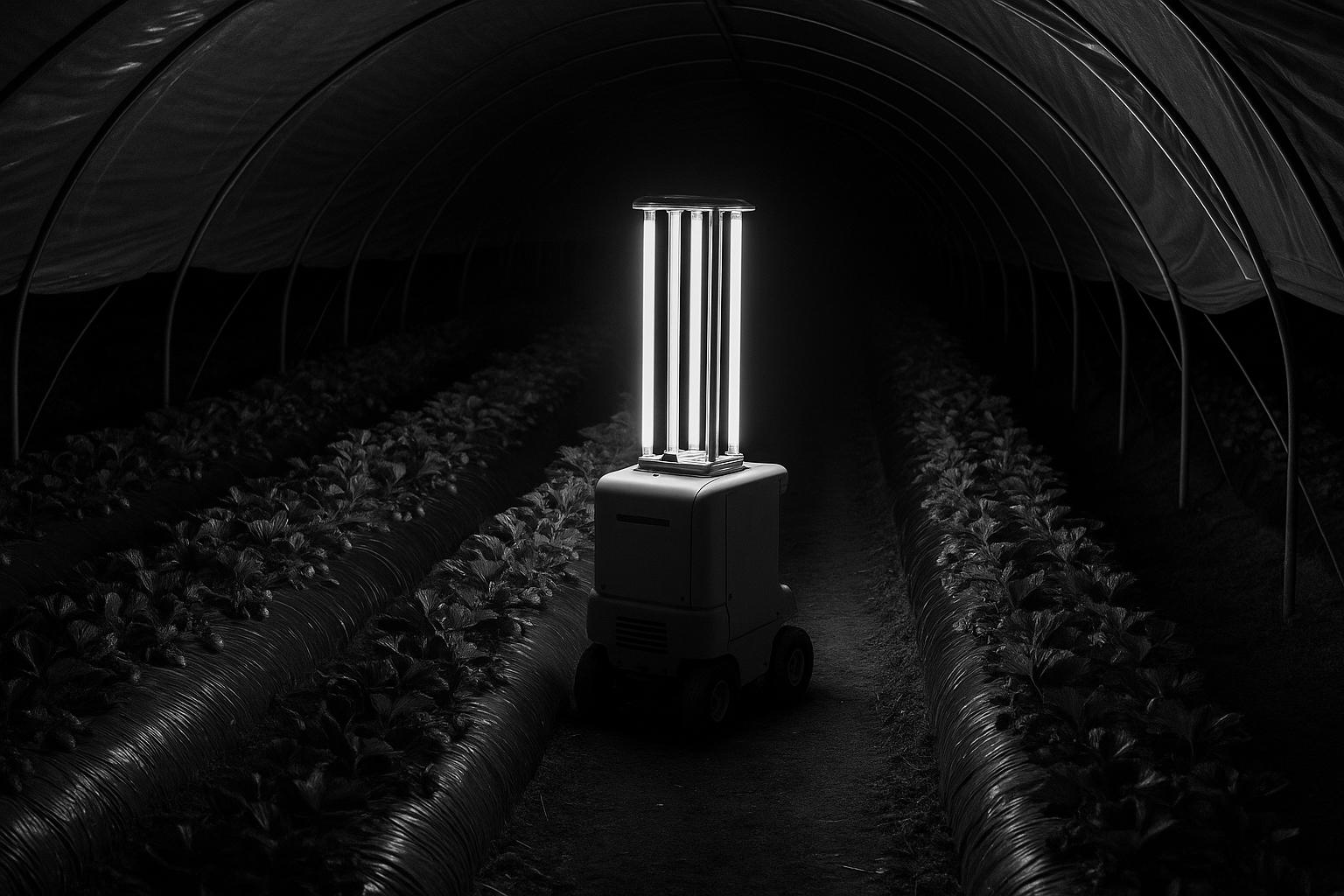Place UK has implemented Norway-designed Thorvald UV-light robots and AI-driven FruitCast technology to combat crop disease and optimise yields, advancing sustainable strawberry production on over 11 hectares in Norfolk.
Place UK, located in Tunstead near North Walsham, has emerged as one of the UK’s leading strawberry producers, harvesting over 1,500 tonnes annually from approximately 1.5 million plants. The company has integrated advanced automation and robotics into its operations, aiming to enhance efficiency while minimising environmental impact. This commitment to innovation is evidenced by their adoption of renewable energy sources, including ground-source heat pumps, and sophisticated irrigation systems that utilise rainwater harvested from the roofs of their extensive plastic polytunnels.
Central to their recent advancements is the deployment of the Thorvald robot, an autonomous device engineered in Norway. This robot effectively combats powdery mildew—a significant threat to strawberry crops—by applying bursts of shortwave ultraviolet light during the night. This innovative approach not only spares the need for chemical fungicides but also optimises the treatment conditions, ensuring the efficacy of the UV exposure. Dan Yordanov, head of fresh at Place UK, noted that multiple Thorvald robots operate across 11 hectares of strawberries, delivering treatments twice weekly. “We are continuously looking for ways to improve and automate,” he explained, highlighting the ongoing collaboration with technology firms to enhance their operations.
The integration of robotics in strawberry cultivation is not unique to Place UK. Other growers, such as Dyson Farming, have also implemented UV-light robots within their glasshouse operations, similarly reducing reliance on chemical treatments. These methods demonstrate a growing trend among UK strawberry cultivators, with reports indicating that robots are now treating approximately 10% of the UK’s strawberry crops, according to Saga Robotics. This shift towards using high-intensity UV-C light treatment underscores a collective movement towards sustainable agricultural practices.
Place UK is also employing advanced AI technologies, such as the FruitCast system, which predicts plant growth and yield based on digital imagery. This innovation allows for better planning in terms of labour and market supply, thus enhancing operational efficiency. The intersection of AI and robotics in modern farming signifies a transformative era in agricultural practices, contributing to improved yields and sustainability.
Despite these technological advancements, Yordanov cautioned against the notion that automation could soon replace manual labour entirely. He anticipates that human expertise will continue to play a critical role alongside these new technologies. “For quite a bit of time still, the technologies and the people will go hand in hand,” he remarked, indicating a balanced approach where human and robotic capabilities complement one another.
As part of their commitment to sharing knowledge and fostering future innovation, Place UK recently hosted a tour for 20 young researchers from the Early-Career Innovators’ Forum, organised by Agri-TechE. Dr Laura Bouvet, knowledge exchange manager at Agri-TechE, expressed enthusiasm for the opportunity to expose future influencers in the industry to cutting-edge agricultural practices. “Seeing the intersection of science, innovation and farming is always exciting,” she stated, emphasising the importance of collaboration and shared learning in shaping the future of agriculture.
With current developments firmly rooted in sustainable practices, Place UK stands as a model for the future of strawberry farming—balancing technology with a commitment to preserving the environment and enhancing productivity.
 Reference Map:
Reference Map:
- Paragraph 1 – [1], [4]
- Paragraph 2 – [1], [2], [5]
- Paragraph 3 – [3], [6]
- Paragraph 4 – [1], [2], [7]
- Paragraph 5 – [1], [3]
- Paragraph 6 – [1], [6]
Source: Noah Wire Services
- https://www.edp24.co.uk/news/25229838.place-uk-deploys-uv-robots-produce-norfolk-strawberries/?ref=rss – Please view link – unable to able to access data
- https://www.hortidaily.com/article/9461240/uk-strawberry-grower-uses-uv-light-robot-to-keep-powdery-mildew-at-bay/ – Dyson Farming, a UK-based strawberry grower, has implemented a UV light robot to combat powdery mildew in their glasshouse operations. The robot, which operates overnight, uses UV-C light to target the disease, reducing the need for chemical treatments. This innovation aligns with Dyson Farming’s commitment to sustainability and quality, offering a promising solution for disease control in strawberry cultivation.
- https://www.northnorfolknews.co.uk/news/24051242.fruitcast-ai-technology-trialled-norfolk-strawberry-farm/ – FruitCast, an AI-based technology, has been trialled at a Norfolk strawberry farm to forecast plant growth. By capturing digital imagery of millions of berries, the system uses AI to predict growth and yields up to six weeks in advance. This tool aids growers in planning labour and market supply, enhancing efficiency in strawberry production.
- https://www.fruitfocus.co.uk/uv-robot-control-of-powdery-mildew-on-strawberry – The UV-ROBOT project, presented at Fruit Focus LIVE, showcases an environmentally friendly solution for controlling powdery mildew in strawberries. Utilizing UV-C light, the robot delivers precise treatments during the night, effectively reducing fungal infections by up to 80%. This innovation offers a sustainable alternative to chemical fungicides in strawberry cultivation.
- https://www.fpcfreshtalkdaily.co.uk/post/revolutionising-strawberry-farming-thorvald-robots-treat-10-of-uk-crop – Saga Robotics’ Thorvald robots have expanded their services to treat approximately 10% of the UK’s strawberry crops. These robots employ high-intensity UV-C light to control powdery mildew, significantly reducing pesticide use and environmental impact. Their adoption by major growers in Kent, Scotland, and southern England marks a significant advancement in sustainable strawberry farming.
- https://www.fruitnet.com/fresh-produce-journal/thorvald-robots-now-treat-one-in-10-uk-strawberries/261158.article – Saga Robotics has significantly expanded its Thorvald robotic services in the UK, now treating nearly one in ten UK strawberries. The Thorvald 3 robot uses high-intensity UV-C light to control powdery mildew, reducing the need for chemical interventions. This advancement positions Saga Robotics as a leading provider of autonomous robotics in the UK’s agricultural sector.
- https://www.eurofresh-distribution.com/news/uv-c-light-removes-need-for-fungicides/ – Saga Robotics’ Thorvald robot has successfully eliminated the need for chemical fungicides in controlling powdery mildew on strawberry plants at Clock House Farm. The UV-C light treatment provided by the robot has proven effective, aligning with the farm’s commitment to sustainability and reducing environmental impact in strawberry cultivation.
Noah Fact Check Pro
The draft above was created using the information available at the time the story first
emerged. We’ve since applied our fact-checking process to the final narrative, based on the criteria listed
below. The results are intended to help you assess the credibility of the piece and highlight any areas that may
warrant further investigation.
Freshness check
Score:
8
Notes:
The narrative presents recent developments in Place UK’s adoption of UV-C light robots for strawberry cultivation. While similar technologies have been reported in the UK since 2021, such as Saga Robotics’ Thorvald robot achieving a season free of powdery mildew sprays in December 2021 ([farminguk.com](https://www.farminguk.com/news/robot-delivers-world-first-season-free-of-powdery-mildew-sprays_59536.html?utm_source=openai)), the specific focus on Place UK and their current implementation suggests a recent and original report. However, the absence of earlier publications on this exact development raises questions about the novelty of the information.
Quotes check
Score:
7
Notes:
The direct quotes attributed to Dan Yordanov and Dr. Laura Bouvet do not appear in the provided search results, indicating they may be original to this report. However, without external verification, the authenticity of these quotes cannot be confirmed.
Source reliability
Score:
6
Notes:
The narrative originates from the Eastern Daily Press (EDP), a regional newspaper in the UK. While EDP is a known publication, its regional focus may limit the reach and verification of its content. The lack of corroboration from other reputable sources raises concerns about the reliability of the information.
Plausability check
Score:
8
Notes:
The claims regarding Place UK’s use of UV-C light robots for strawberry cultivation align with known advancements in agricultural technology. Similar technologies have been reported in the UK since 2021, such as Saga Robotics’ Thorvald robot achieving a season free of powdery mildew sprays in December 2021 ([farminguk.com](https://www.farminguk.com/news/robot-delivers-world-first-season-free-of-powdery-mildew-sprays_59536.html?utm_source=openai)). However, the absence of earlier publications on this exact development raises questions about the novelty of the information.
Overall assessment
Verdict (FAIL, OPEN, PASS): OPEN
Confidence (LOW, MEDIUM, HIGH): MEDIUM
Summary:
The narrative presents recent developments in Place UK’s adoption of UV-C light robots for strawberry cultivation. While similar technologies have been reported in the UK since 2021, the specific focus on Place UK and their current implementation suggests a recent and original report. However, the absence of earlier publications on this exact development, the lack of corroboration from other reputable sources, and the unverifiable quotes raise concerns about the freshness, originality, and reliability of the information. Further verification from additional reputable sources is recommended to confirm the accuracy and novelty of the claims.













